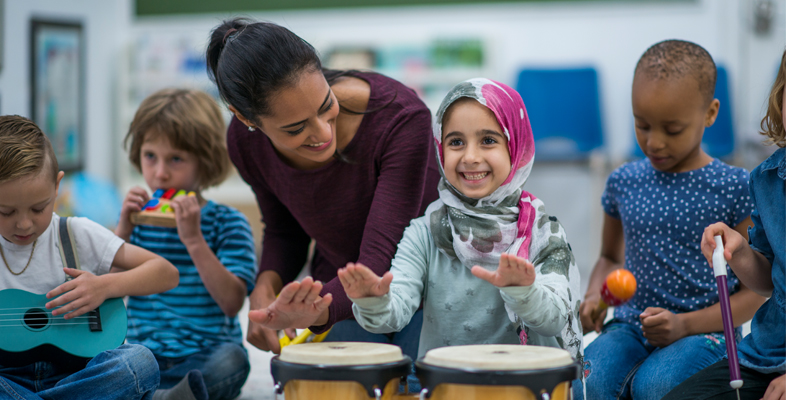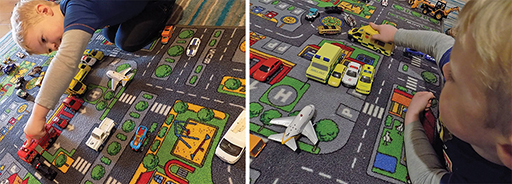3.1 Learning stories as boundary objects
Some children might bring a portfolio of ‘learning stories’ into a new setting which also function as boundary objects. These documents, often collated in previous settings, use photographs and narrative observations of a child’s experiences to support them to reflect on their activities (Carr and Lee, 2012). Below is an extract from a book of learning stories that Henry brought with him as he moved to a new group room in his nursery.
Box 2 Henry to the rescue!
Henry, I really enjoyed listening to your story about the people trapped at the airport that you told today when playing on the car mat. You sorted the vehicles into ambulances and fire engines and carefully moved them around the roads to complete their rescue mission. It was kind of you to let your friends join in with your story. You shared your ideas with them, and listened to their ideas too. It was really clever of you to send the biggest ambulance and fire engine to the rescue, and you explained to your friends, that these would have the most room for people who might be hurt, and be able to carry the most water.
There are different ways of writing learning stories, but the principle is to create a narrative that engages a child in reflecting on their learning. In Henry’s story, the use of photographs and personalised dialogue support him to recall his perspectives and to know that his learning is valued. He has been used to sharing such stories with practitioners and his parents throughout nursery. They have been an important tool for listening to him and sharing such stories in a new room will help unfamiliar practitioners make new connections with him. By sharing the story the practitioners will recognise that he is a problem solver, collaborator and explorer. They may be prompted to introduce him to the spaces and places where his skills might be applied and his interests fulfilled, so supporting his transition into his new environment.
The value of using learning stories as boundary objects is highlighted in the following example from Carmen Huser, Sue Dockett and Bob Perry’s research which followed one group of children’s transition from kindergarten to first school in Germany.
… the kindergarten educators developed portfolios for children, consisting of learning stories to highlight children’s competence, learning and dispositions. Collaboration resulted in the adoption of the same approach by school educators. These portfolios accompanied the children to school, and were used both as ‘icebreakers’ in discussions about school readiness, and as the basis for ongoing communication with educators, families and children. Children, who had been involved in documenting their own learning, were excited to share the portfolios with school teachers and to talk about their kindergarten experiences with teachers and new classmates…In many ways, the learning stories provided a meeting place where all participants could gather to share their own achievements …
You can see from this example that listening to children through their learning stories, can support them to make meaning with others about their identity as learners as well as develop an understanding of the role they might adopt in different settings.
Summary points
- Boundary objects are physical items that can be carried between the boundaries of home and setting, and their meanings shared with others.
- Sharing the meaning of boundary objects can provide an opportunity to listen to children’s perspectives about their identity.
- Learning stories can be used as boundary objects. When they are shared they enable children to make meaning about their place in a new learning community and help others include the child more readily.
Activity 3 Thinking about boundary objects
What other objects in children’s lives might be taken across the boundary to a new setting in order to discuss their identity?
Imagine that you were going to start a new job or were joining a new group for the first time. If you were asked to share some objects that reflect your interests, from home or other situations that say something about you what would you share? Make a short list of 5 objects in the space provided below:
Now think of a child that you know well. It may be your own child and you may have had experience of them moving into school or pre-school. What special objects would have been or will be appropriate for them to share that reflect their interests and who they are? Again make a short list of 5 objects in the space provided below:
Now look at both the lists and reflect on any connections between the type of objects that were chosen and the reasons why they were selected.
Discussion
Although very different, both lists are likely to have the following aspects in common: both let others know about people that are important; both feature things that interest or motivate; both include things that calm and sooth.
Sharing such objects would support listening to you as the new person and establish a clear identity for you in the new group. Of course as an adult there would have been things that you did not want to share – aspects of your identity that you did not initially want to reveal to new people. In choosing boundary objects with young children you should also take these issues into perspective. Boundary objects should support being listened to and so settling in a new environment rather than add to your feeling of alienation.

